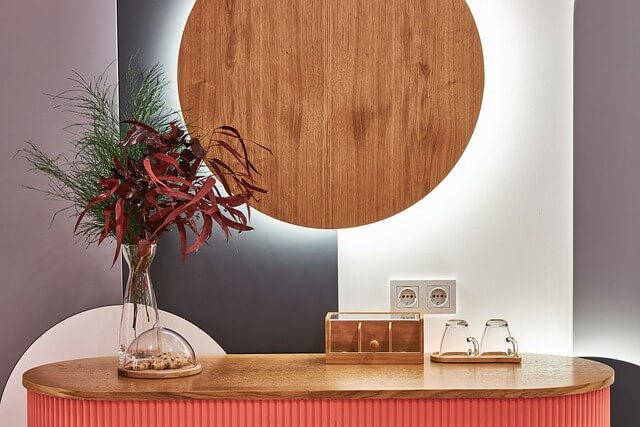The concept of integrating nature and architecture is called Biophilic Design. This fusion has become imperative in light of the need to introduce new models that would further enhance the aesthetics of modern buildings.
In this article, we talk about the best possible ways to fuse nature and modern architecture for a remarkable architectural design.
What is Biophilic Design?
It is the process of integrating nature and modern architecture. This allows for the inclusion of nature-like elements that further bolster the connection of nature to the overall outlook of an architectural design.
How to Leverage Biophilic Design in Architectural Development
The best possible ways to add nature to architecture include integrating nature-like elements, such as sunlight and water. It is also possible to explore other means, such as living walls and green roofs.
Read on to find out how to make this integration work.
1. Use Natural Materials
This is the most logical way to add nature to any modern architecture. Using natural materials helps you to make the point without much effort. What’s more? You have more than one option to choose from. A good way to start is by using wood and related materials (bamboo, clay and mud).
If you are in the mood to step up things and vary options; go for nature-like colour palettes. Examples are rusty shades, shades of grey and brown.
Also Read: Architectural Symbolism: Decoding Hidden Meanings in Buildings
2. Opting for Biomaterials Wouldn’t be a Bad Idea
While using materials sourced from the immediate environment works; it may also be a good idea to explore similar options. Using biomaterials or in essence, nature-inspired building materials can also help.
In this case, you are leveraging materials that are not only inspired by nature but which also have little or no negative environmental impact.
Biomaterials like stone, mycelium and wood readily come in handy to help you create the desired nature-to-modern architecture design.
3. The Choice of Interior Elements is also Important
In the lead-up to blending nature and architecture; it is important to have a broader perspective. As much as the exterior is worth the attention; the interior is also worth considering. Hence, the choice of interior elements forms part of the basis for fusing nature and architectural designs.
By using planters, natural stones and sculptures inside the home; they would go a long way to give off the feeling of “living in nature.”
4. Go for Natural Upholstery
The future is getting greener and you should start making plans to port too. The upholstery used in the home has a role to play in the fusion of nature and architecture. Selecting furniture made from silk, wool or cotton fibre enhances breathability while bolstering the resilience of the upholstery.
5. Nature is Fused into Modern Architecture via Natural Views
The feeling that comes with waking up in a villa to the view of a green landscape can’t be quantified. If that inspires, it would be a major boost to your architecture’s aesthetics to map out ways to create that natural view.
Here are tips on how to make this work:
- Locate the structure where daylight can easily penetrate.
- Having a structure where sunlight can be accessed is also a good idea.
- You may want to cite the structure in areas where natural elements like rivers, trees, mountains and terrains can be viewed.
6. Use the “Vernacular Architecture” Model
What could be a better way to integrate nature and architecture than using a medium that makes the connection worthwhile?
The concept of Vernacular Architecture suggests the use of natural (construction) materials obtained within the immediate environment. Doing this is helpful in the following ways:
- It supports using traditional materials, especially those within the architectural site.
- Leveraging Vernacular Architecture boosts or deepens the connections humans or the inhabitants of the architecture will have to nature. The possibility is based on the derivation of most of the materials from the local ecology.
7. Incorporate Nature into Architecture via Inspiration
Are you running out of options on how to make nature pronounced in your next architectural project? Perhaps, you should look around and get some ideas based on what you can see.
The concept of Biomorphic Architecture suggests taking architectural inspiration from the common shapes found in nature. Many buildings and architectural edifices have been constructed through this means.
A direct inspiration based on the shape of popular natural elements like birds, trees and animals can go a long way to make this design work.
Also Read: 7 Amenities to Expect in a Standard Pickleball Facility
8. Add Greenery to Your Architectural Design
Nature is loosely translated to mean anything that has to do with the state of being green. Hence, based on the foregoing, you may want to fuse nature and architecture by adding some green-like elements into your design.
Whether it is green roofs or herb gardens; rest assured that the versatility makes it stand out. You could also explore other greenery options, such as living walls, flowers and houseplants. Any element that can be watered and or gives off the “cool feeling” can be considered for integration.
Conclusion: Keeping the Immediate Environment Tidy Might Just be the Way Out
Sometimes, we assume that all there is to integrating architecture with nature is using specific green-like elements both indoors and outdoors. While that works, other options can be used to derive a similar or better result. Keeping the environment clean is one such inexpensive way.
We are talking about “taking good care of the immediate environment” so it doesn’t cause “nature to revolt.’
Take an instance to be a clear, cut-out plan on how to keep the environment tidy and park out used items so they don’t further biodegrade the atmosphere.
If such measures are in place and kept up with, then we can be sure that the existing fusion between nature and architecture will last.
Finally, the integration of nature and architecture requires strategy, knowing what to do and add and when the same is needed. Furthermore, architects can explore creating minimalistic designs induced in nature, integrating core natural elements (such as space, fire and water) or having landscape areas and open spaces.










